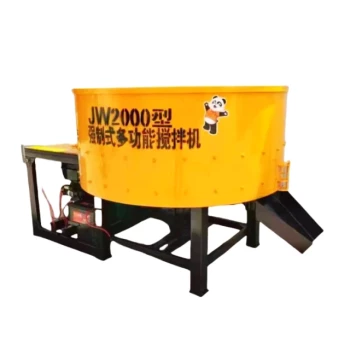Using a cement mixer significantly improves health and safety on construction sites by reducing physical strain, minimizing respiratory hazards, and enhancing overall efficiency. Manual mixing poses risks like musculoskeletal injuries and dust inhalation, while mechanized mixing ensures consistent results with less human effort. The benefits extend to cost savings, time efficiency, and better site organization, making it indispensable for modern construction projects.
Key Points Explained:
-
Reduction in Musculoskeletal Injuries
- Manual cement mixing requires repetitive heavy lifting and prolonged use of back, shoulder, and arm muscles, leading to strains or chronic injuries.
- A cement mixer automates the mixing process, eliminating the need for strenuous manual labor and reducing the risk of muscle pulls or long-term musculoskeletal disorders.
-
Minimized Respiratory Hazards
- Dry cement and other mixing materials release fine dust particles, which, when inhaled, can cause silicosis or other respiratory issues.
- Mechanized mixing encloses the process, reducing airborne dust exposure. Some models even feature dust suppression systems for added safety.
-
Improved Workplace Efficiency
- Faster mixing speeds up project timelines, reducing worker fatigue and associated safety risks from prolonged manual labor.
- Consistent mixing quality ensures structural integrity, indirectly preventing accidents due to poorly mixed materials.
-
Cost and Labor Benefits
- Fewer workers are needed for mixing, lowering the risk of overcrowding-related accidents.
- Reduced dependency on manual labor cuts costs linked to injury compensation or absenteeism.
-
Enhanced Site Organization
- Portable mixers allow on-site mixing, minimizing spillage and tripping hazards from transporting pre-mixed materials.
- Tidy worksites reduce slip-and-fall incidents, a common cause of construction injuries.
-
Versatility and Adaptability
- Modern mixers handle diverse materials (e.g., concrete, mortar) with adjustable settings, reducing the need for risky manual adjustments mid-task.
- Electric models eliminate fumes from gas-powered alternatives, improving air quality.
Have you considered how integrating a cement mixer could transform not just safety but also the economic and logistical dynamics of your projects? These machines exemplify how simple technological interventions can profoundly impact worker well-being and operational efficiency.
Summary Table:
| Benefit | Impact |
|---|---|
| Reduced Injuries | Minimizes musculoskeletal strain from manual mixing. |
| Lower Respiratory Risks | Enclosed mixing reduces dust inhalation (e.g., silicosis). |
| Faster Workflows | Speeds up projects, cutting fatigue-related accidents. |
| Cost Savings | Fewer labor injuries and absenteeism lower operational expenses. |
| Tidier Sites | On-site mixing prevents spillage and tripping hazards. |
| Versatile Use | Handles multiple materials safely; electric models reduce fumes. |
Upgrade your construction site’s safety and productivity with GARLWAY’s durable cement mixers. Designed for contractors and construction firms, our equipment reduces labor risks while delivering consistent results. Contact us today to find the ideal mixer for your project needs!
Related Products
- HZS75 Concrete Batching Plant Cement Mixer Price Concrete Mixer Bunnings Mixing Plant
- Auto Concrete Cement Mixer Machine New
- JZC1000 Industrial Concrete Mixer Machine Cement Mixer Price
- Concrete Cement Mixer Machine Drum Mixer for Construction
- HZS25 Best Cement Mixer for Quick Mix Concrete at Bunnings
People Also Ask
- How much weight can a cement mixer hold? Understanding Capacity for Optimal Use
- Can you mix mortar in a cement mixer? Pros, Cons & Best Practices
- Can you mix self leveling concrete in a cement mixer? Why Specialized Equipment Matters
- How do I choose a cement mixer? Find the Perfect Mix for Your Project
- Do you put water or cement in a cement mixer first? The Right Order for Perfect Concrete



















